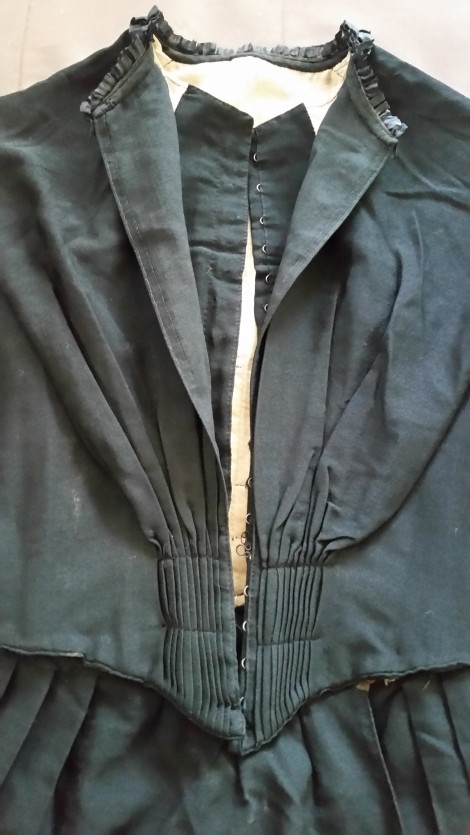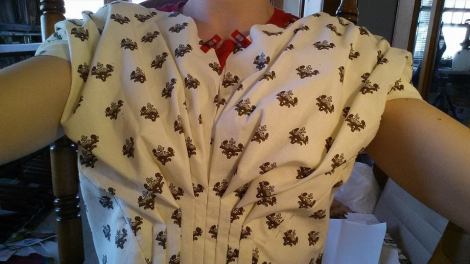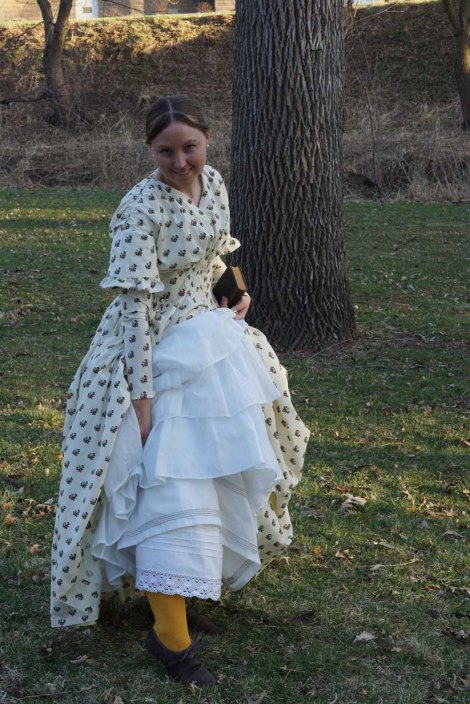This summer, I was very happily minding the shop one day, when my mom told me she had been at a garage sale that morning, and they had some antique underwear and hats there. As I collect antique underwear, I didn’t want to miss out, so as soon as I closed the shop, I picked her up, and off we went!
We started out the sale by inspecting and acquiring a very large box of vintage hats, mostly from the 50’s and 60’s. In the garage, I found an excellent bearskin muff and a white silk turn of the century graduation style dress. There were a few antique nightgowns on the rack, but nothing that special. About then, the lady asked if I liked old clothes, and told me she had more inside. Oooooooooh.
The moment I stepped into the room, I saw it. Hanging on the wall in unassuming plainness, but undeniable. I didn’t want to act too excited there, so I added it to my pile, and got a box of antique underwear, and a black lace dress from about 1907, and a few other random things from the room. I left shirtwaists and camisoles, and it was sad, but I had limited funds.
But this. This was worth it. I now have a front opening fan-front 1840’s dress.
There are not many of these around. I couldn’t find any on pinterest, and found only a few on a google search. I found this purple silk one in a google search, and that’s about it. I suspect that is because a fan front style is easier to sew with a single piece than with an opening right down the middle of it.
The dress is sewn of lightweight black wool, with a fan front and front opening, and a smaller fan in back. It is somewhat smaller than my dress form, as you can see.
The front opening closes with hooks and eyes. It’s really neat and tidy, and if everything is hooked up, you can barely see the closure. The edges just butt right up to each other.
The hooks on the bodice are sewn in between the layers, except for one that apparently ripped out at some point and was sewn back on. Ooops!
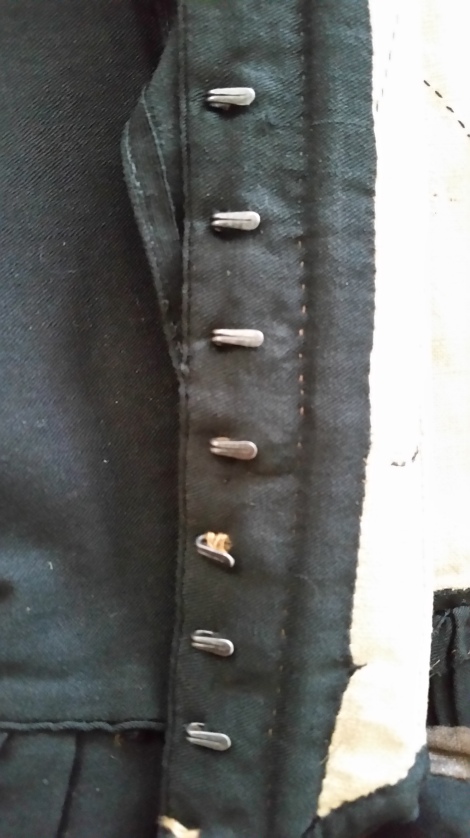
Bodice Hooks

Pocket!
There is a pocket sewn into the right skirt front, right at the edge of the narrow front panel. It’s faced with dress fabric, but the pocket itself is made of cotton. (Top of the pocket is at the right in the above picture.) The picture below shows the inside of the skirt, with the pocket. As you can see, the front panel of the skirt was pieced, right at the top! Meanwhile, the top edge of the skirt is overcast and folded over before being pleated and set to a cotton waistband/ binding.

Pocket on Inside, Plus Piecing
The skirt is sewn straight across the waistline of this dress, and the waist seam ends a little past the front of the side seam. It appears that the waist would have hooked straight across on a waistband, then the bodice closed over. You can see the piecing in the front panel here.

Front Skirt Panel of 1840’s Dress

Back of Waistband
The skirt pleats are very even, and yes, those are boning channels above!

1840’s Skirt Facing
The skirt has a very deep facing of polished cotton, and there is horsehair braid sandwiched between the facing and the skirt fabric, extending about 1/8″, to prevent wear to the hem. There is a tuck about 1″ deep above the facing, which accounts for the stitching line you see in the above photo. Most of the skirt seams are very narrow, with selvedge sewn to selvedge, except for this one, which is the narrow front panel seam. Its one cut edge is whip stitched to prevent fraying.

Inside Back of 1840’s Dress Bodice
The lining is made of a heavy rough linen. Heavy fabrics were often used as linings to support the bodice and prevent warping or stretching. The back lining has pieces carefully patched in right at the shoulder. Apparently, her piece of fabric wasn’t quite large enough in the right ways. The shoulder seam is very neatly whip stitched to finish the edge.

Pieced Back Lining

Front Boning Channel with Baleen
Yep! One of the original baleen stays! You’ll notice there are diagonal lines sewn with a running stitch through the lining in both the front and back. This prevents the fan front (and back) from collapsing outward and looking slouchy or untidy. Even after all these years, the dress is well-shaped, thanks to the careful thought that went into constructing it.

Basically Shoulder Pleats
The diagonal stitching lines are down under the diagonal lines in the bodice, essentially creating diagonal pleats in the bodice. The running stitches hold it in place, and are hidden completely on the outside of the dress.

Diagonal Stitching Line
Our original seamstress didn’t care how nice her stitches were if no one else could see them!

The Stitching from the Outside
Let’s take a moment to admire her piping, however. See how tiny and neat it is?

Lovely 1840’s Piping!
For the collar, there is piping, horsehair braid, AND a tiny silk ruffle. The tiny plain ruffle makes my friend Kay think this is a mourning dress, but I’m still undecided. I tend to think this was simply a best dress, with a little bit of fancy trim around the collar.

1840’s Collar Treatments Galore!

Front Collar Treatment
In the front of the collar, the lining snakes its way out of the piping binding, and becomes the faced front hook and eye closure, while the collar treatment continues on and becomes the front fashion fabric opening, with the hooks at the neck and down at the fan. Very nice way of solving that problem!
Now, let’s talk sleeves:

1840’s Dress Sleeve
The sleeve is moderately full, but not so full that it is gathered or pleated into the armscye. It is pleated neatly into a narrow cuff, and the front edge has fullness pleated into the elbow, to allow for freedom of movement. As you can see, the sleeves are pieced, both exactly symmetrically.

1840’s Sleeve Cuff
The sleeve cuff has a narrow band of silk velvet ribbon sewn on as trim, with a hook and thread eye closing each sleeve. The velvet is worn threadbare, enough so one can see it was simply tacked on with a double running stitch, with the threads hidden in the pile of the velvet originally.
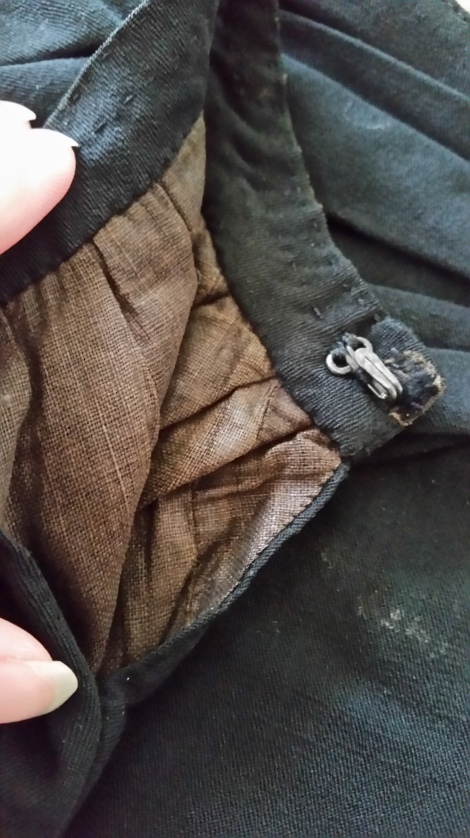
1840’s Sleeve Cuff and Lining
The sleeve lining is pieced, and has some shattering up by the elbow. My guess is that the fabric wore thin there from movement.

1840’s Dress Armscye
The armscye is trimmed close and whip stitched all around. I think the cord up there is made of linen, but I’m not entirely sure of its purpose. Perhaps it had something to do with hanging the dress when not worn.

Front of 1840’s Dress Flat
I’m still ridiculously pleased with this piece of history, and it is on my reproduction list, as soon as I have time. I’m sure I will learn even more about how it was made when I begin the process of reproducing it. In the meantime, it is safely packed away in an archival box, away from sunlight and bugs. (It is no longer hanging on a wire hanger in an old house.)
Thanks for reading, and as always, I’m very happy to answer questions!




